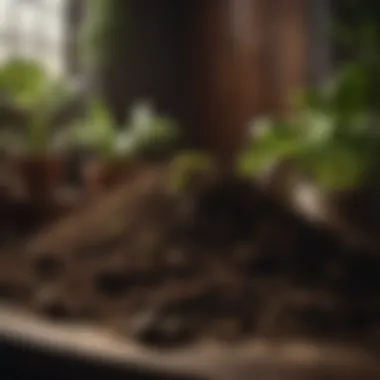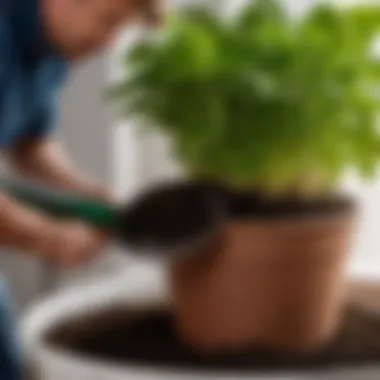Unlocking the Potential: A Comprehensive Guide to Using Compost for Indoor Plants


Materials:
- Organic compost (3 lbs)
- Potting soil (2 lbs)
- Small indoor plant pots (3)
- Watering can
- Trowel
DIY Steps:
- Begin by mixing organic compost and potting soil in a 2:1 ratio in a large container and blend thoroughly.
- Fill the small indoor plant pots with the compost and soil mixture, leaving some space at the top for planting.
- Select indoor plants suitable for the compost mix and gently plant them in the pots.
- Water the plants generously using a watering can, ensuring the soil is moist but not waterlogged.
- Place the pots in a sunny spot with indirect light to promote plant growth.
Technical Aspects:
- Tools: Trowel, watering can
- Timing: Planting should be done in the morning or evening to prevent stress on the plants
- Critical Techniques: Ensure proper drainage in the pots to prevent waterlogging and root rot
DIY Project Process:
- Mix the compost and soil thoroughly to create a nutrient-rich growing medium
- Plant the indoor plants carefully, ensuring they are positioned at the appropriate depth
- Water the plants according to their individual watering needs, avoiding overwatering
Troubleshooting Tips:
- If plants appear wilted, adjust watering levels to prevent water stress
- Yellowing leaves may indicate nutrient deficiencies, consider adding organic fertilizer to the compost mix
Enjoy the lush and healthy growth of your indoor plants nurtured by nutrient-rich compost with these detailed and precise instructions. Your green friends will thrive in this sustainable gardening practice, bringing beauty and vitality to your indoor space.


Introduction
Compost, often touted as 'black gold' in the gardening world, plays a crucial role in fostering robust plant growth and soil health. In this comprehensive guide on using compost for indoor plants, we delve deep into the intricacies of this sustainable gardening practice. From enriching soil structure to enhancing nutrient availability, understanding the importance of compost is key to cultivating thriving indoor greenery. Throughout this article, we will explore the composition of compost, various types available, and the myriad benefits it offers to indoor plants. Whether you are new to gardening or a seasoned plant parent, mastering the art of utilizing compost indoors can revolutionize how you nurture your beloved greens. Join us on this enlightening journey as we uncover the wonders of incorporating compost into your indoor plant care regimen.
Understanding Compost
'Understanding Compost' holds significant importance within this comprehensive guide on using compost for indoor plants. This section delves into the intricate details of compost composition, types, and benefits, providing readers with a robust foundation for implementing compost in their indoor gardening practices.
Composition of Compost
Organic Matter
Organic matter is a crucial component of compost due to its role in enhancing soil fertility and structure. Comprised of decomposed plant and animal materials, organic matter enriches the soil with essential nutrients, improves water retention, and fosters microbial activity. Its ability to break down slowly ensures a sustained release of nutrients, making it a favored choice for maintaining healthy indoor plants.
Microorganisms
Microorganisms play a vital role in the composting process by breaking down organic matter into rich humus. Bacteria, fungi, and other microorganisms facilitate decomposition, leading to nutrient-rich compost that nourishes indoor plants. Their activity helps create a balanced ecosystem within the soil, promoting plant growth and health. While essential for composting, proper balance and diversity of microorganisms are crucial for optimal compost quality.
Nutrient Content
The nutrient content of compost varies depending on the materials used in its creation. Compost serves as a valuable source of essential nutrients such as nitrogen, phosphorus, and potassium, vital for plant growth. Its organic nature ensures a slow release of nutrients, promoting sustained plant health and vigor. However, variations in nutrient levels based on compost ingredients require careful monitoring to prevent nutrient deficiencies or excesses in indoor plants.


Using Compost for Indoor Plants
Using compost for indoor plants is a vital aspect of maintaining a healthy and thriving indoor garden. In this comprehensive guide, we will delve into the significance of incorporating compost into your indoor plant care routine. Compost serves as a rich source of organic matter, microorganisms, and nutrients essential for plant growth. By understanding the composition of compost and its benefits for indoor plants, you can make informed decisions to enhance the health and vitality of your green companions.
Choosing the Right Compost
Selecting the appropriate compost for your indoor plants is crucial for ensuring optimal growth and development. Consider factors such as the organic matter content, nutrient levels, and microbial activity present in the compost. Vermicompost, leaf mold, and green waste compost are popular choices known for their diverse nutrient profiles and microbial richness, promoting soil fertility and plant vigor.
Compost Application Techniques
- Topdressing: Topdressing involves the application of a layer of compost on the soil surface around the base of the plant. This method offers a slow-release of nutrients, improves soil structure, and enhances nutrient availability for plants. Its ease of application and ability to nourish plants gradually make it a favored choice among indoor gardeners.
- Incorporation into Soil: Incorporating compost into the soil through mixing ensures uniform distribution of nutrients and organic matter. This technique boosts soil fertility, promotes microbial activity, and enhances water retention capacity, benefiting indoor plants' overall health and growth.
- Compost Tea Preparation: Compost tea preparation involves steeping compost in water to create a nutrient-rich liquid fertilizer. This natural plant tonic enhances nutrient uptake, improves soil microbial diversity, and boosts plant resilience against diseases. Regular application of compost tea can significantly contribute to the vitality of indoor plants.
Considerations for Indoor Use
Indoor composting requires attention to specific factors to optimize plant growth and health within an enclosed environment.
- Moisture Levels: Maintaining appropriate moisture levels in the soil is crucial for preventing waterlogging or drought stress. Regularly monitor the moisture content of the compost to ensure optimal conditions for plant growth.
- Odor Control: Managing compost odor in indoor settings is essential for a pleasant living environment. Utilize proper aeration, effective layering techniques, and odor-neutralizing additives to minimize unpleasant smells associated with composting.
- Potential Pests: Indoor composting may attract pests such as fruit flies or gnats. Implement strategies such as covering compost bins securely, using pest-resistant containers, and practicing proper compost management to deter potential pest infestations and maintain a pest-free indoor garden.
Maintaining Indoor Plants with Compost
In this section of the article, we delve into the crucial aspect of maintaining indoor plants with compost, highlighting the significance of proper care for thriving greenery. When it comes to indoor plants, the role of compost goes beyond initial application to ongoing maintenance, ensuring optimal growth and health.


Monitoring Plant Health
Monitoring plant health is an essential task for indoor plant care, as it allows you to track the well-being of your green companions closely. Regular monitoring involves observing the leaves for any signs of discoloration, wilting, or pest activity. Additionally, checking the soil moisture levels and overall plant growth can provide valuable insights into their health status.
Troubleshooting Common Issues
Overwatering
Overwatering is a common issue that indoor plant enthusiasts encounter, often leading to root rot and nutrient leaching. In the context of this article, addressing overwatering is crucial to prevent waterlogged soil and promote proper drainage. Ensuring that indoor plants receive adequate but not excessive watering is key to their survival and vigor.
Nutrient Deficiencies
Nutrient deficiencies can manifest through yellowing leaves, stunted growth, or leaf discoloration. Understanding nutrient deficiencies is vital in sustaining plant health with compost. By diagnosing specific nutrient deficiencies and amending the soil with nutrient-rich compost, indoor plants can regain their vitality and thrive.
Pest Infestations
Pest infestations pose a threat to indoor plants, jeopardizing their well-being. Identifying common pests like spider mites, aphids, or fungus gnats is paramount in mitigating infestations. Utilizing compost as a natural pest deterrent can fortify indoor plants against potential threats, ensuring a healthy and pest-free environment.
Conclusion
In this comprehensive guide on using compost for indoor plants, the Conclusion section plays a pivotal role in tying together all the essential elements discussed throughout the article. As readers journey through the various aspects of compost composition, application techniques, and considerations for indoor use, they are ultimately led to this concluding segment, which encapsulates the significance of incorporating compost into indoor plant care routines.
One primary importance of the Conclusion section is its function in summarizing the key takeaways presented in the earlier sections. By recapping the benefits of compost for indoor plants, ranging from enhancing soil structure to promoting microbial activity, readers are reminded of the positive impact that this sustainable gardening practice can have on the overall health and growth of indoor greenery.
Moreover, the Conclusion serves as a platform to emphasize the importance of sustainable gardening practices in today's world. By highlighting how composting can contribute to reducing waste, enriching soil fertility, and fostering a greener environment, readers are encouraged to adopt eco-friendly approaches in their plant care routines.
Another crucial aspect of the Conclusion is its role in offering guidance on next steps for readers. Whether it involves implementing compost application techniques, monitoring plant health, or troubleshooting common issues, this section aims to empower readers with practical insights that they can readily apply in their indoor gardening endeavors.
Ultimately, the Conclusion segment acts as the nexus that connects theory to practice, providing readers with a holistic view of how utilizing compost for indoor plants can yield tangible benefits and contribute to a more sustainable and thriving indoor garden environment.







